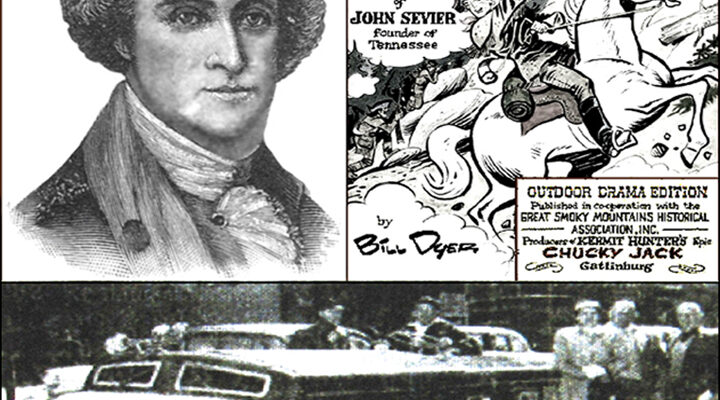John Sevier (1745-1815), noted Tennessee history frontiersman, became known as “Chucky Jack.” His accolades were fearless Indian fighter, hero of the Battle of Kings Mountain and other Revolutionary War encounters, first governor of the short-lived State of Franklin and the new State of Tennessee and a U.S. Representative.
In 1955, the R.L. Maples family, Gatlinburg hotel owners, built Hunter Hills Theatre on 24.57 acres of land to feature an outdoor drama that accurately personified the life of Sevier. The 2500-seat facility was located about four miles outside the heart of Gatlinburg. It was named after Kermit Hunter, a successful drama writer who taught history on a stage under the stars. It was Hunter’s third drama, the other two being “Unto These Hills” (1949, Cherokee, NC) and “Horn in the West” (1951, Boone, NC). He later added several more productions.

The Maples’ aim was to attract tourists who routinely traveled 35 miles across a narrow, winding mountain road to see the popular drama in Cherokee. The play opened in 1956 with performances scheduled from late June to early September. Viewing “Chucky Jack” was described as a painless, pleasurable way to learn early Tennessee history in the coolness of pristine mountain air.
The play employed 92 actors, some of whom had previously worked on Broadway. Others were college drama students and local residents. The main stage was 55 feet wide and equipped with two 30-foot revolving stages that allowed speedy set changes.
Promoters of the event devised a clever attention-grabbing stunt to draw attention to the new enterprise. They purchased what appeared to be a train for $13,000 from an amusement Company in Dayton, Ohio. The vehicle, comprised of a Diesel-looking locomotive and two cars, ran on the road rather than a rail. The word “Tennessee” appeared across the front of it. The new owners drove it from Dayton to Gatlinburg to draw media attention along the 350-mile stretch of highway. Local newspapers and television stations were curious about them.
Accompanying the train on its overland trek were Mr. and Mrs. Maples; their son, Jack, who piloted the train; and Bart Leiper, a director of public relations for Gatlinburg and “Chucky Jack.” When the train finally arrived at its mountainous destination, it assumed a new role – providing sightseeing around the city for tourists and rides to and from the theatre. During the 1957 season, major script changes were made to the play. Also, an organ and a special trained chorus replaced tape recordings.
In 1958, a 24-page brightly illustrated comic book titled, “Chucky Jack’s A-Comin’” was published that was aimed primarily at youngsters. Bill Dyer, well-known cartoonist for the Knoxville News-Sentinel (famous for his “Dyergrams” of the Tennessee Volunteer football games), provided the artwork. Bill modestly commented that all he had to do was let history tell its own story. He simply supplied the pictures and released the imprints for it.
Over time, attendance at “Chucky Jack” performances began to wane in spite of efforts to publicize it. John Sevier, as impressive as he was in Tennessee history, was not as recognized to the general public as were other Volunteer State notables such as Davy Crockett, Daniel Boone, Andrew Jackson and Sam Houston. Another problem was the three-hours length of the play, but Hunter refused to shorten it by even one word.
In 1959 after a brief three-year run, “Chucky Jack” was chucked. The early pioneer left the open-air stage and returned to history books. In December 1965, the Maples’ family donated the theatre to the University of Tennessee.

Comments are closed.